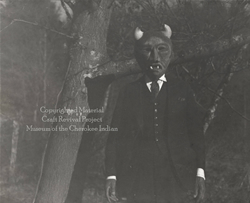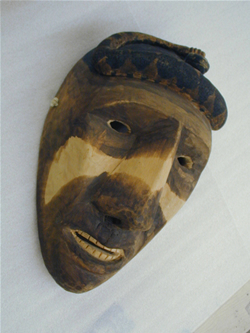Lesson Plans:
Cherokee Origin Stories:
A People's Belief About the World's Beginnings
Subject(s)/Grade(s): 10th Grade English II - World Literature
Related Subject(s): World History, Art
Learning Outcomes
This lesson has two major connections to the Craft Revival:
- Students can explore the collection for traditional Cherokee basketry, carvings, and pottery that employ Origin Stories and other cultural knowledge into design. They may be able to draw connections from other crafts as well. For example: the use of cornhusks to craft objects characteristic of the mountain culture.
- Craft Revival is its own form of origin story, as artists adapt to preserve, grow, and cultivate their own cultural heritage through their arts and crafts.
- Students will create an origin story utilizing essential elements of the genre.
- Students will draw connections across cultures.
- Students will read for theme, cultural significance, and comprehension.
Teacher Planning
- Time required for lesson - 1.5 hrs for notes, reading, and discussion. Approx. 3 hrs writing and revision time (may vary)
Materials/Resources
- Cherokee History, Myths and Sacred Formulas by James Mooney: Copies of "Daughter of the Sun" (pgs 252-254 in 2006 edition)
- Student white boards (You can use white printer paper inserted into clear plastic page protectors) - 1 per student
- White board markers - 1 per student
- Various random objects for writing prompt - at least 1 per group (Teachers may choose to have students select an object from the Craft Revival website collection)
- Overhead projector
- PowerPoint capabilities
- Access to Craft Revival website CraftRevival.wcu.edu
- Optional: Computers for group writing assignment
Procedures
Pre-Activities:
- Students will have prior experience with Aesop's Fables or similar material and basic understanding of theme.
- Teachers should introduce the Craft Revival website to students and allow time for exploration.
Activities:
- PowerPoint notes
Students will take notes on important terms from Origins and Creation Myths and on vocabulary terms: theme, allegory, myth, origin story, creation and story/myth. "Origins and Creation Myths" also includes various international examples of origin stories for referencing. Teachers may choose which ones (if any) to share. - Class discussion
Students will use personal white boards to quick write their answers to: What are your origin stories? All students will be asked to share with the class. Possible answers include: religious references (ex. Book of Genesis), American historical documents, cultural traditions. Teachers may need to help students recognize everyday documents as origin stories. It may help to give them the example of the "Star Spangled Banner." What role does it serve in our nation? Once they have written on their white boards, ask them to consider the following questions.- Who or what is responsible for this creation?
- Why are different elements of life created? Is the force responsible for the creation benevolent, cruel, or both? Explain.
- What role do humans play in this story?
- What elements of human life are explained in this creation story?
- Small group reading of story with assigned task questions:
Students will work in groups of approximately four and read the story "Daughter of the Son" from Mooney's anthology. Members can be assigned roles such as: reader, recorder, presenter, and time moderator/leader; all members should participate in discussion. Each group will have different topic questions to discuss. Choose from either basic understanding questions or higher order thinking questions according to group composition.
Basic Understanding Questions:- Highlight and discuss or look up words/terms that are confusing or unknown.
- Discuss possible examples of figurative language.
- Explain the basic events taking place in the story.
- What does this story say about the values of early Cherokees?
- Does this story provide an allegory or allegories? If so, what is it?
- What are some possible themes of this text?
- Can you relate the story's events or messages to any stories from other cultures?
- Class discussion
Small groups will take turns discussing their reading topics with the class
- Identify, predict, and describe the results of transformations of plain figures.
- Group origin stories/projects
Small groups will choose an object from a table. They will be asked to write a 2-3 page origin story for the object. This story should be completely fictional. They will make new origins and uses for the item they choose. Each group will be asked to address:- Cultural significance
- Explanation of events or occurrences
- Displayed values
- Easily passed from generation to generation
Assessment
- White board responses - Participation, incorporates knowledge from Power Point
- Large group reporting - Fulfills designated group responsibility
- Group origin story - Student groups read stories to their classmates and receive feedback from teachers and classmates. Students are assessed on inclusion of genre elements and grammar/spelling. If time allows, the teacher may choose to have the class design a grading rubric for the project. Along with buy-in, this action helps students recall the elements of origin stories as well as other criteria for effective writing.
Comments
This plan can be adapted to other subjects and grades etc. English I students do well with this plan after studying literature such as Homer's Odyssey. This plan would also work complimentary with World History.
North Carolina Curriculum Alignment
Grade 11 – NC English II: World Literature: 1.01, 1.02, 1.03, 2.01, 2.02, 2.03, 4.02, 4.03, 4.04, 4.05, 5.01, 5.02, 5.03, 6.01, 6.02
Grade 11 – English II – English Language Arts (2004)
Sources
- Mooney, James. Cherokee History, Myths and Sacred Formulas. Cherokee, NC: Cherokee Publications, 2006.
Websites
- http://craftrevival.wcu.edu/
– Submitted by Annette Saunooke Clapsaddle, Swain County High School, Bryson City, North Carolina.





